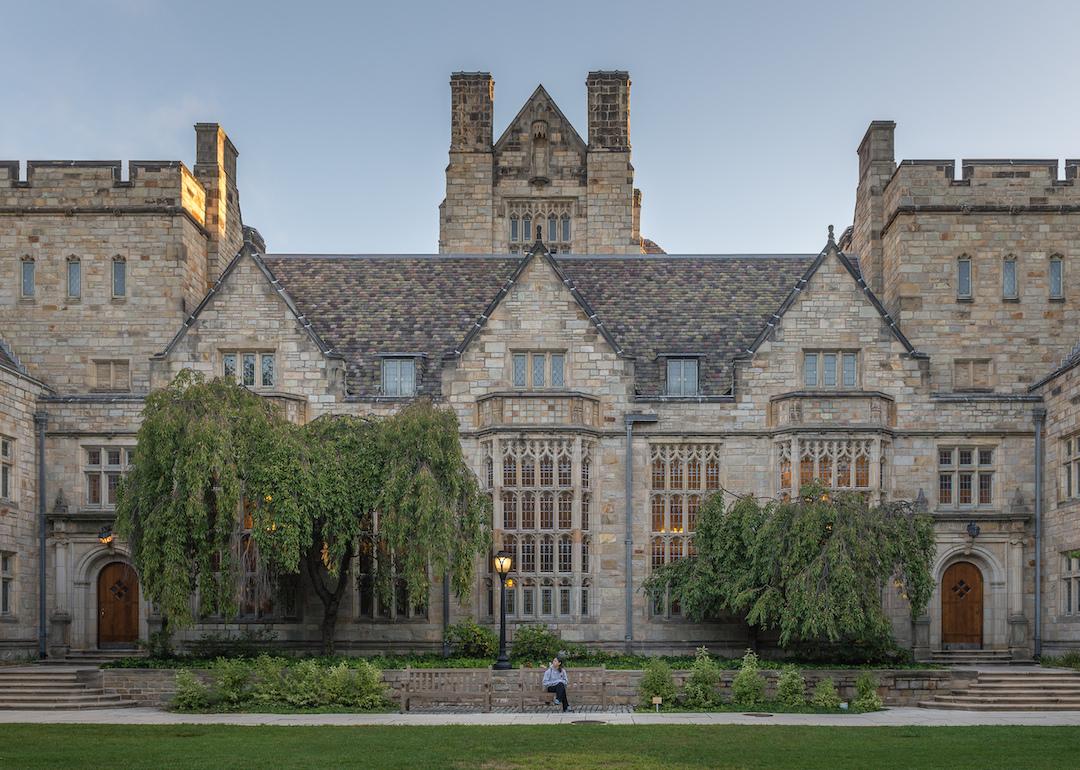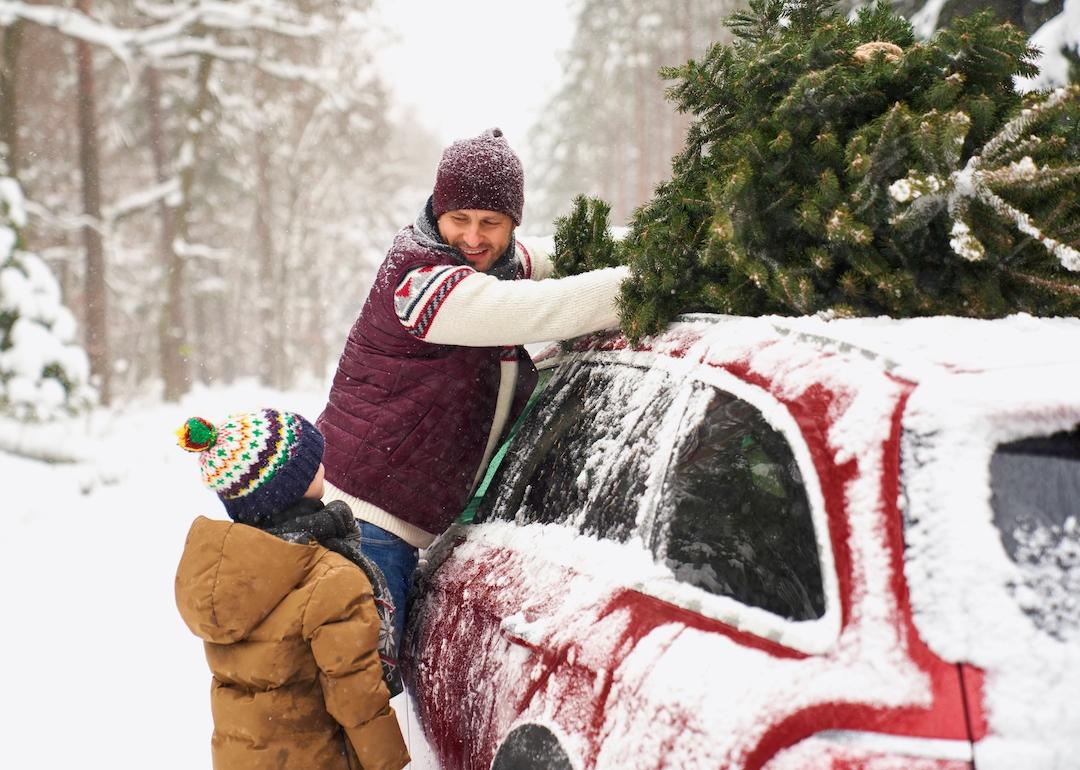
States that produce the most Christmas trees
States that produce the most Christmas trees
Nothing beats a real Christmas tree, from the crisp evergreen scent to choosing the perfect Tannenbaum to adorn with glistening ornaments come December. Across the U.S., nearly 15 million trees were harvested in 2022 and there were 16,000 tree farms with over 290,000 total acres in production. Christmas trees are a big business, bringing in about $550 million in sales.
The tradition of chopping down and purchasing an authentic Christmas tree from a local farm makes for an unforgettable annual family outing. It's also a sustainable practice: While artificial trees may be made of nonbiodegradable plastics and could contain harmful chemicals, real Christmas trees are a renewable resource and can even be recycled. What's more, for every real Christmas tree sold, as many as three seedlings are planted.
Christmas tree farming creates more than 100,000 full- or part-time jobs. The nation's Christmas tree farms not only fill a critical economic need but also preserve miles upon miles of sacred green space and wildlife.
Stacker compiled data from the 2022 USDA Agricultural Census (released in February 2024), conducted every five years, to identify the states that produce the most Christmas trees. States are ranked by the number of trees harvested in each. Alaska, Nevada, and Arizona did not report information to be included on the list.
Read on to find out which states grow the most trees and which produce more than 1 million.

#47. North Dakota
– Total trees cut in 2022: 227
– Total farms: 9
– Total acres in production: Not available
– Total sales: Not availableAcross North Dakota, several events boost holiday cheer by showcasing Christmas trees. The Christmas Tree Lighting at the Capitol welcomes all community members, while the drive-through Lights on Shriner Hill outside of Jamestown invites viewers to marvel at the more than 100 decorated, still-living trees growing on Mill Hill.
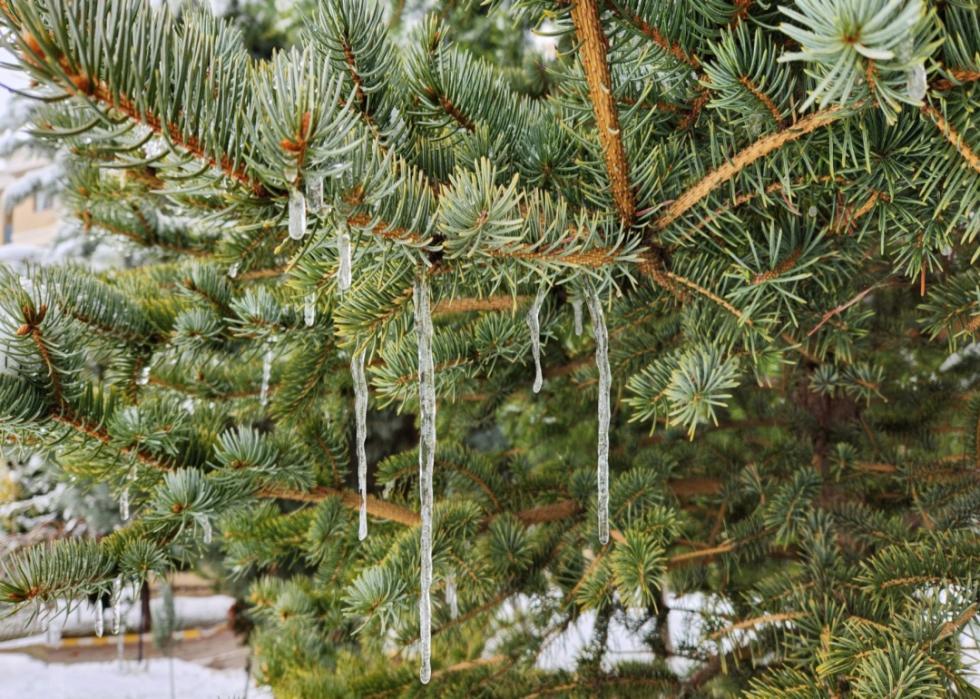
#46. Wyoming
– Total trees cut in 2022: 244
– Total farms: 8
– Total acres in production: 115
– Total sales: Not availableIn 2010, Wyoming's Bridger-Teton National Forest provided a 67-foot-tall Engelmann spruce to serve as the official Christmas tree for the White House. Though Wyoming has not supplied the Capitol's holiday centerpiece before or since, residents can cut down trees with a permit from the Bureau of Land Management.
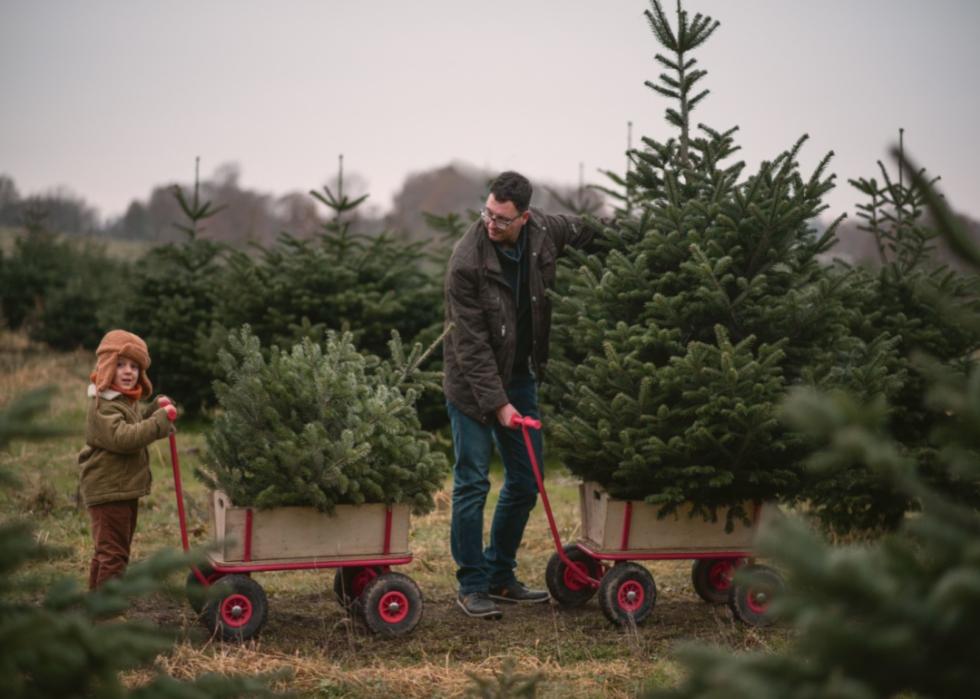
#45. Utah
– Total trees cut in 2022: 1,722
– Total farms: 40
– Total acres in production: 1,063
– Total sales: $82,000People with a permit in Utah can cut their own Christmas trees, as long as they are subalpine fir trees and measure 20 feet or shorter. The permit is issued by the Forest Service and is good until the end of December.

#44. Delaware
– Total trees cut in 2022: 1,780
– Total farms: 19
– Total acres in production: 108
– Total sales: $84,000The Christmas tree erected yearly in Rehoboth Beach is typically the tallest in the state. The lighting celebration features a singalong with the Clear Space Theatre Company.
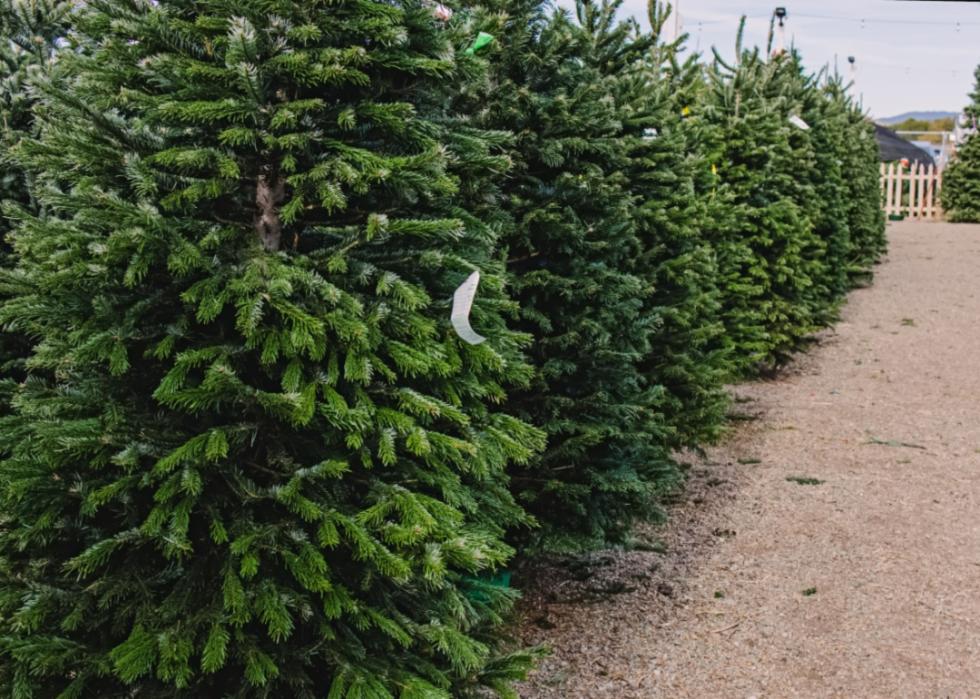
#43. South Dakota
– Total trees cut in 2022: 2,380
– Total farms: 22
– Total acres in production: 101
– Total sales: $185,000More than 90 Christmas trees are the centerpiece of one of South Dakota's beloved Christmas traditions. At Christmas at the Capitol in Pierre, visitors can observe the dozens of spectacularly decorated trees that have been dolled up by nonprofits, businesses, and communities.
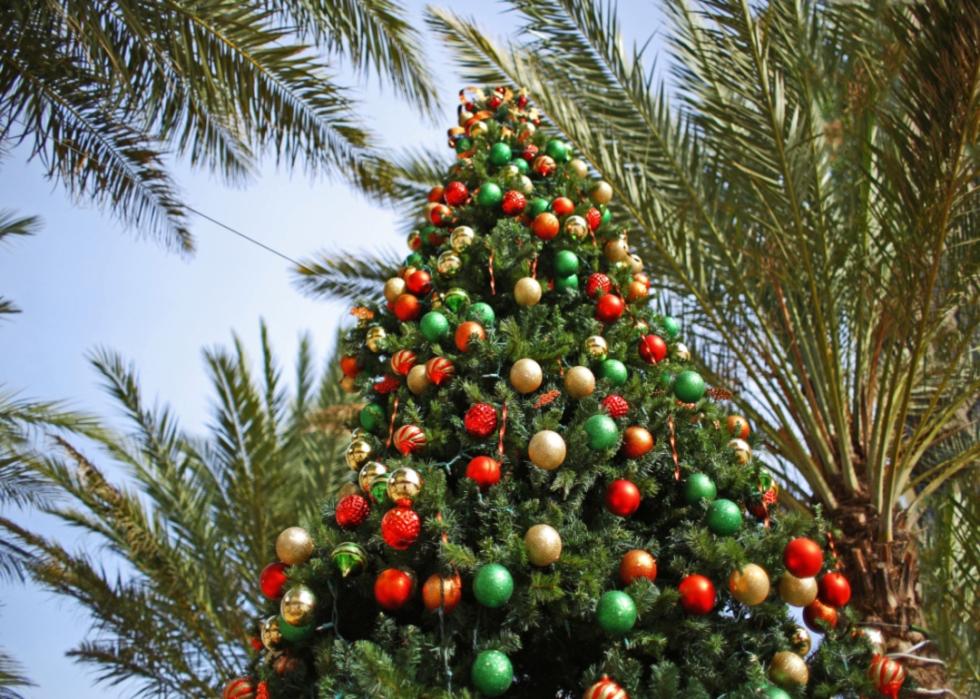
#42. Hawai'i
– Total trees cut in 2022: 2,570
– Total farms: 24
– Total acres in production: 80
– Total sales: Not availableAlthough Hawai'i may not be the typical winter wonderland that comes to mind, Hawaiians still relish the tradition of having fresh Christmas trees. However, the islands only have a handful of Christmas tree farms; many trees get shipped to the state from the mainland.
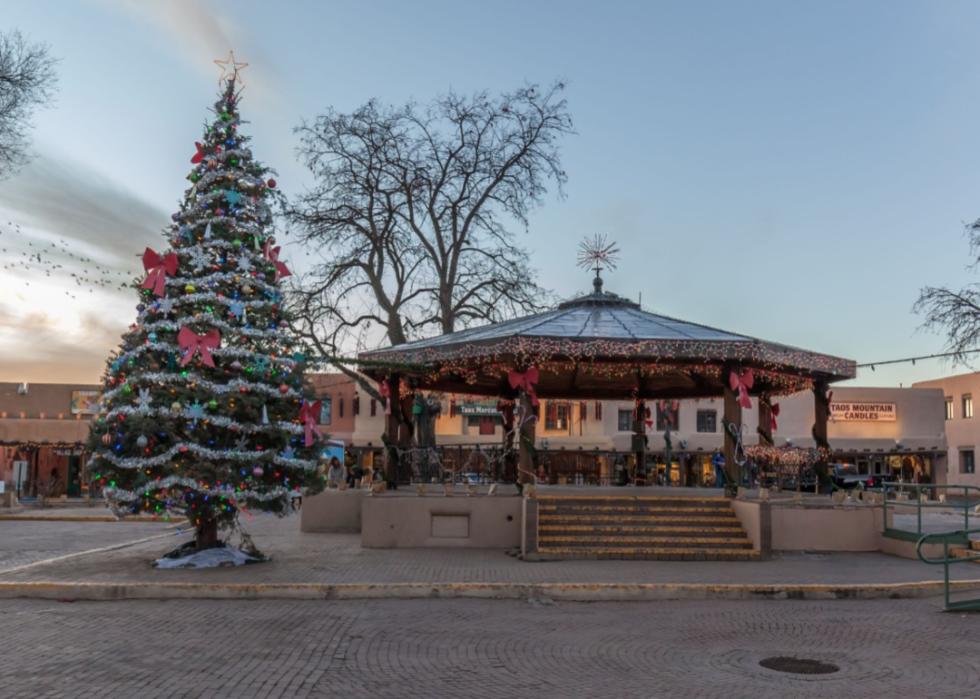
#41. New Mexico
– Total trees cut in 2022: 2,693
– Total farms: 41
– Total acres in production: 729
– Total sales: $182,000Until Christmas 2021, Albuquerque displayed "Henry's Tree," a 55-foot-tall treelike structure with about 150 trees as the branches. The tradition has since been discontinued as the property has come under new ownership.
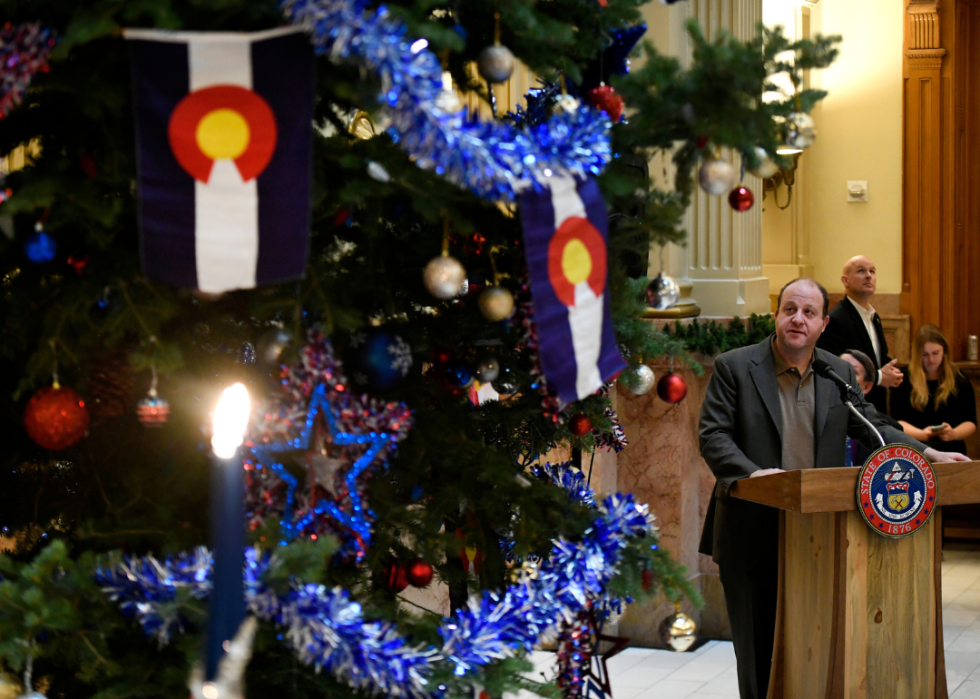
#40. Colorado
– Total trees cut in 2022: 4,667
– Total farms: 178
– Total acres in production: 2,997
– Total sales: $155,000Golden Gate Canyon State Park near Denver offers residents the opportunity to chop down their Christmas trees. Those interested must purchase a permit and can choose between several tree varieties, including Douglas fir, ponderosa pine, lodgepole pine, and Rocky Mountain juniper trees.

#39. Kentucky
– Total trees cut in 2022: 4,748
– Total farms: 182
– Total acres in production: 668
– Total sales: $337,000The day after Thanksgiving typically proves to be busy for most Christmas tree farmers in the state, so if you're set on a Kentucky-bred pine, make sure to tag your pick early. One of the biggest holiday celebrations in the state is Light Up Louisville, featuring a massive Christmas tree and pop-up skating rink.
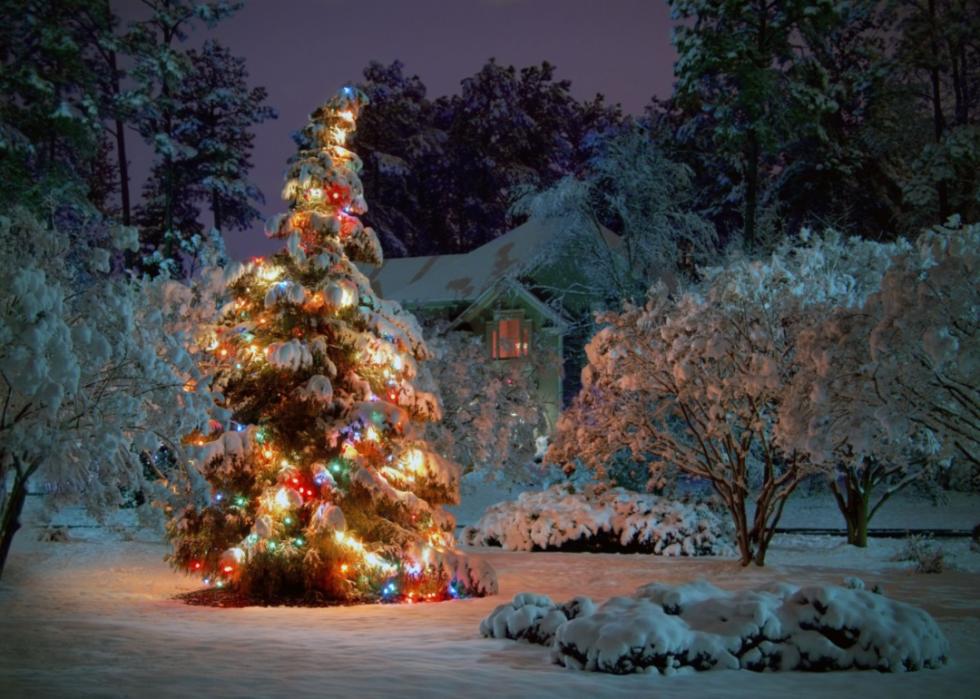
#38. Montana
– Total trees cut in 2022: 6,338
– Total farms: 52
– Total acres in production: 452
– Total sales: $216,000A 2022 Christmas tree from Montana holds the record of the tallest-ever tree to be displayed at the United States Capitol in Washington D.C., towering 89 feet tall. Farms throughout Montana offer cut-your-own, prepacked, and precut trees. There is plenty of land to explore if you'd prefer to cut your own out in a dense forest, but you'll need a permit to do so.
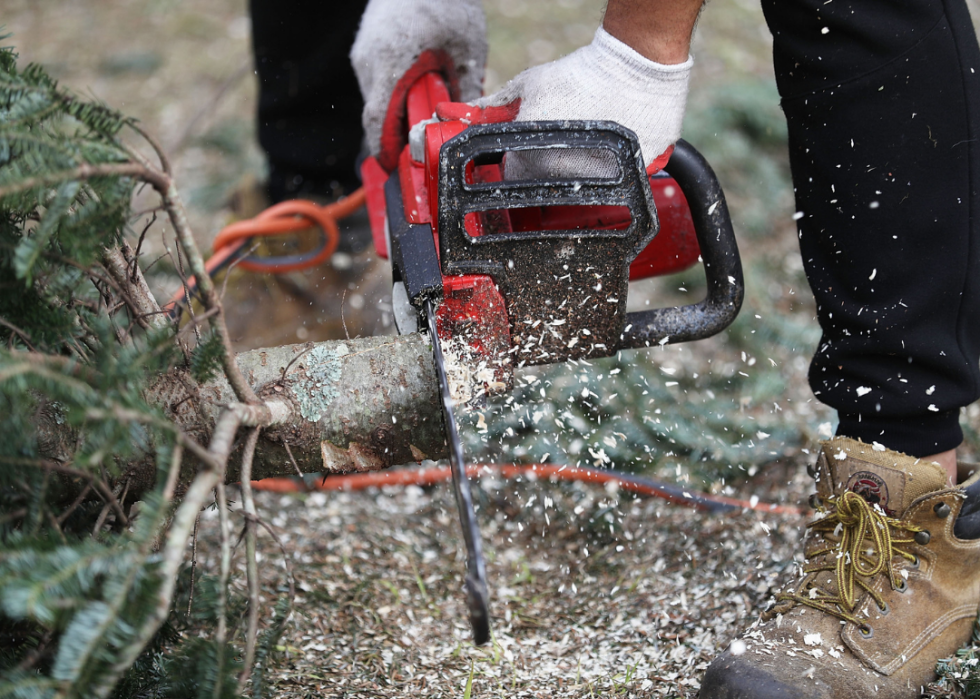
#37. Florida
– Total trees cut in 2022: 8,353
– Total farms: 142
– Total acres in production: 1,076
– Total sales: $375,000Christmas tree farms in Florida grow red cedar, Virginia pine, spruce pine, and Leyland cypress trees for the holiday season. The state reports it takes up to six years to produce a properly shaped tree that reaches 6 to 8 feet.
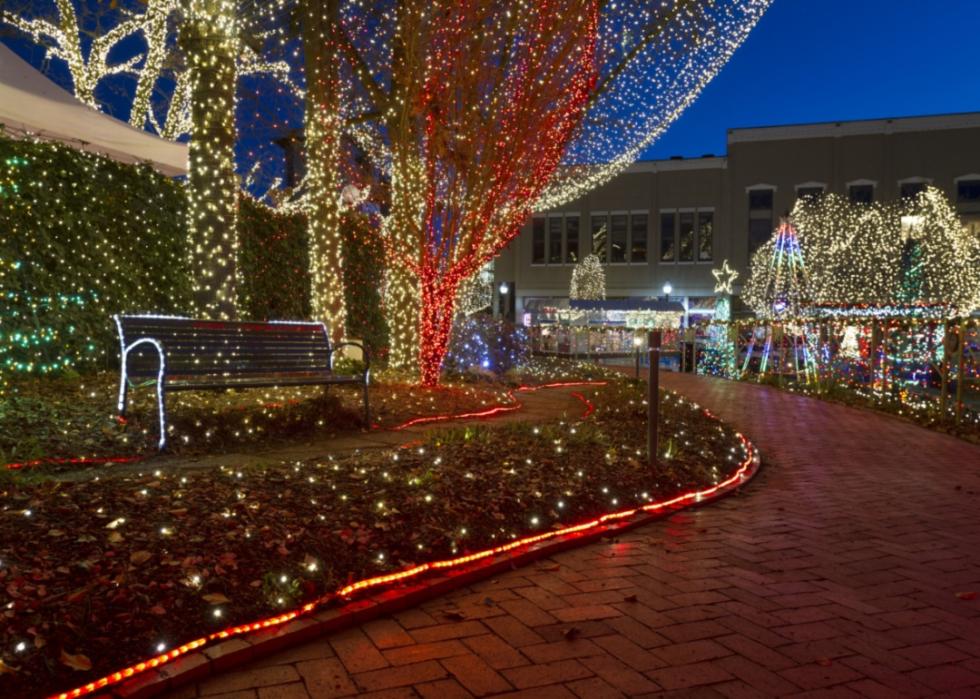
#36. Arkansas
– Total trees cut in 2022: 8,410
– Total farms: 58
– Total acres in production: 226
– Total sales: Not availableThe Arkansas Christmas Tree Growers Association was born in the late 1970s; today, the association operates an annual meeting and workshop and purchases tags, seedlings, and caps for its members. Though its website is dormant for most of the year, it pops up annually as the autumn season rolls in. Visitors can use the site to locate the nearest tree farm and see a complete list of growers throughout the state.
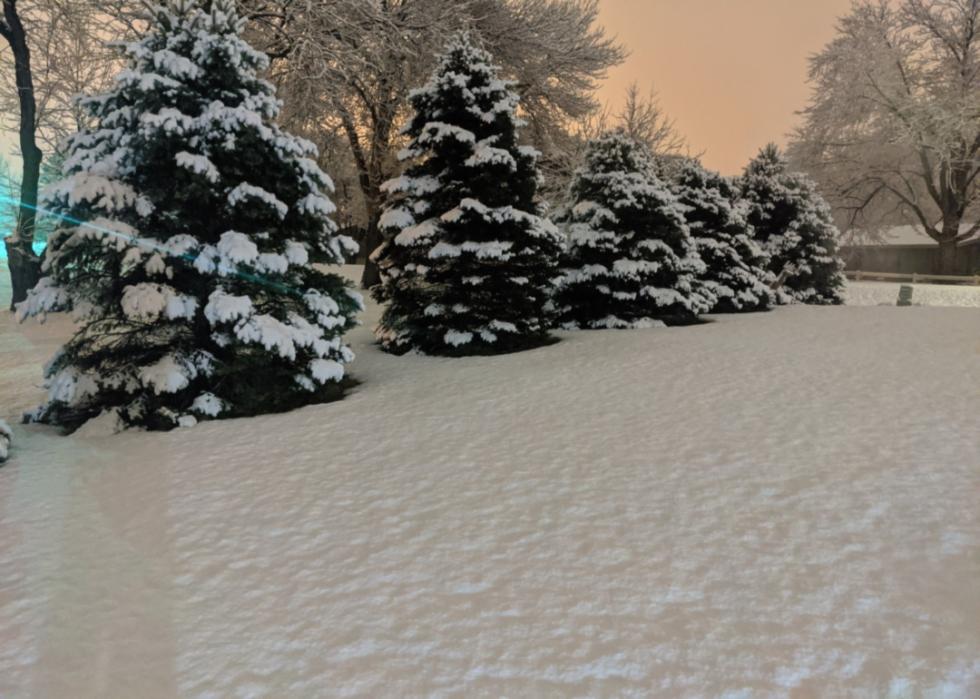
#35. Nebraska
– Total trees cut in 2022: 10,417
– Total farms: 69
– Total acres in production: 366
– Total sales: Not availableNebraska's many Christmas tree farms offer species that include the Scotch pine, Austrian pine, white pine, Colorado blue spruce, and Douglas fir. Locally grown trees support the local economy and environment and can even be recycled come the New Year.

#34. Louisiana
– Total trees cut in 2022: 10,825
– Total farms: 56
– Total acres in production: 283
– Total sales: $822,000Four species of trees make up most of the Christmas trees sold at Louisiana farms: the Leyland cypress, Arizona cypress, Virginia pine, and eastern red cedar. The Leyland cypress is the most popular tree in the Bayou State and is known for its long life span after being cut.
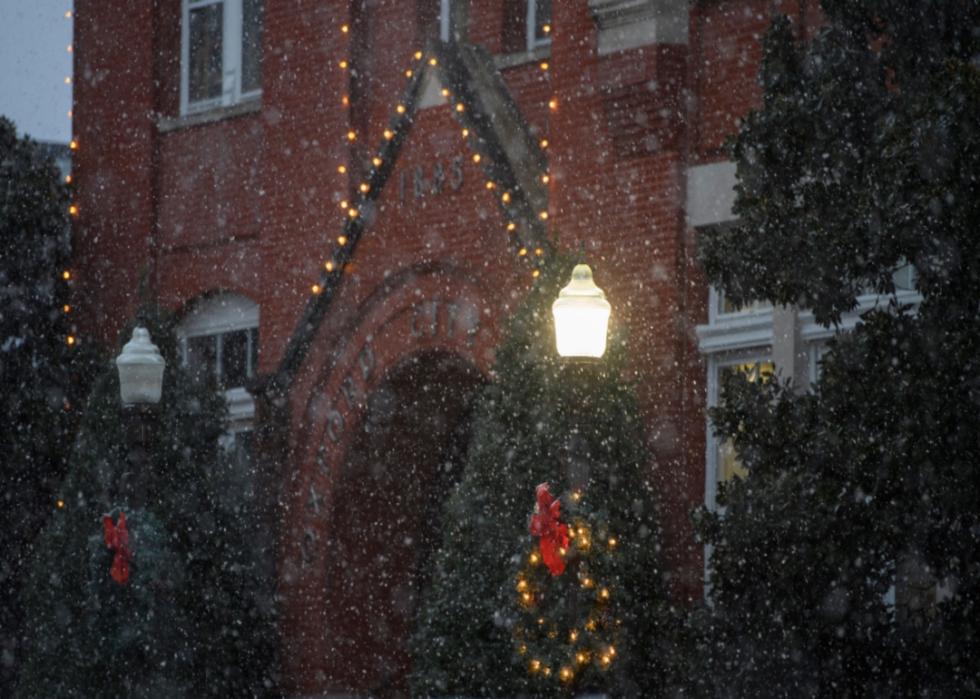
#33. Mississippi
– Total trees cut in 2022: 11,175
– Total farms: 102
– Total acres in production: 547
– Total sales: $718,000Mississippi reached its peak Christmas tree production in 1985, with 450 farms selling 330,000 trees. The Leyland cypress is one of the most popular varieties of Christmas trees in Mississippi. In contrast, the Virginia pine, which is popular in other states, has proven difficult to grow and maintain.
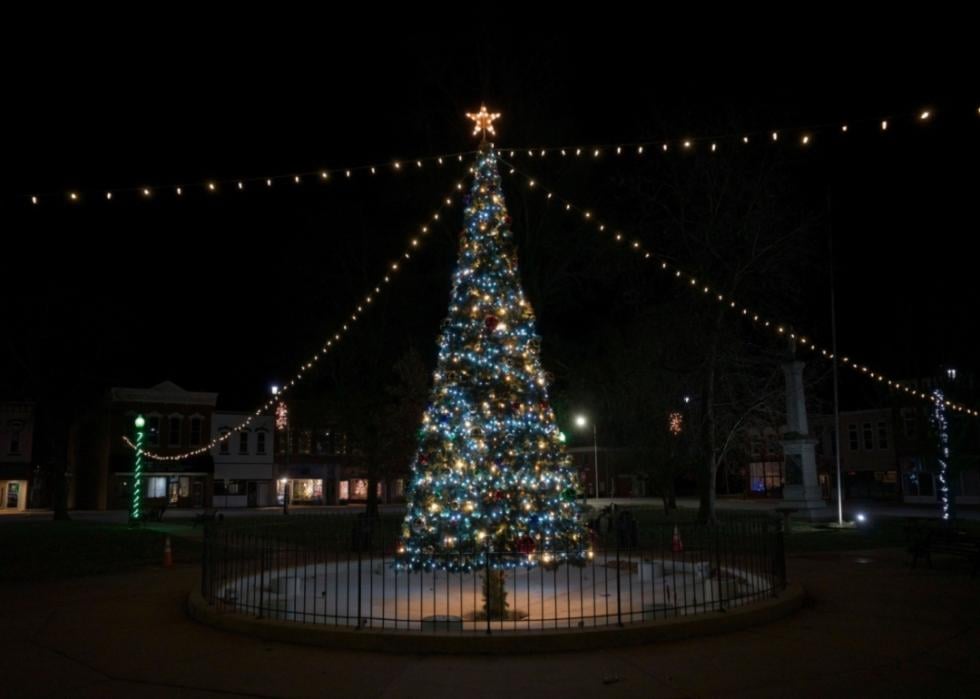
#32. Kansas
– Total trees cut in 2022: 11,204
– Total farms: 75
– Total acres in production: 511
– Total sales: Not availableKansas experienced a shortage of Christmas trees in 2022, along with increased shipping rates. Combined with inflation, the result was higher prices for those shopping for a tree. A 10-foot tree that went for $170 in years past ran as much as $200 at the time.
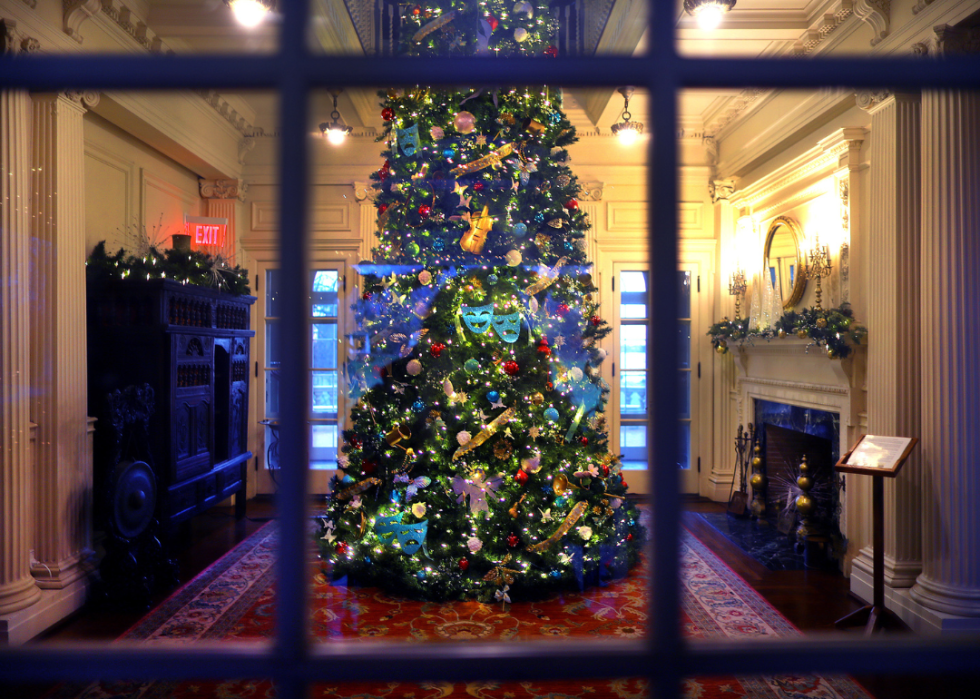
#31. Rhode Island
– Total trees cut in 2022: 11,936
– Total farms: 64
– Total acres in production: 569
– Total sales: $493,000Christmas trees are a significant part of the state's agricultural industry. The most common tree varieties in Rhode Island are the balsam fir, Colorado blue spruce, the white fir, and the Douglas fir.
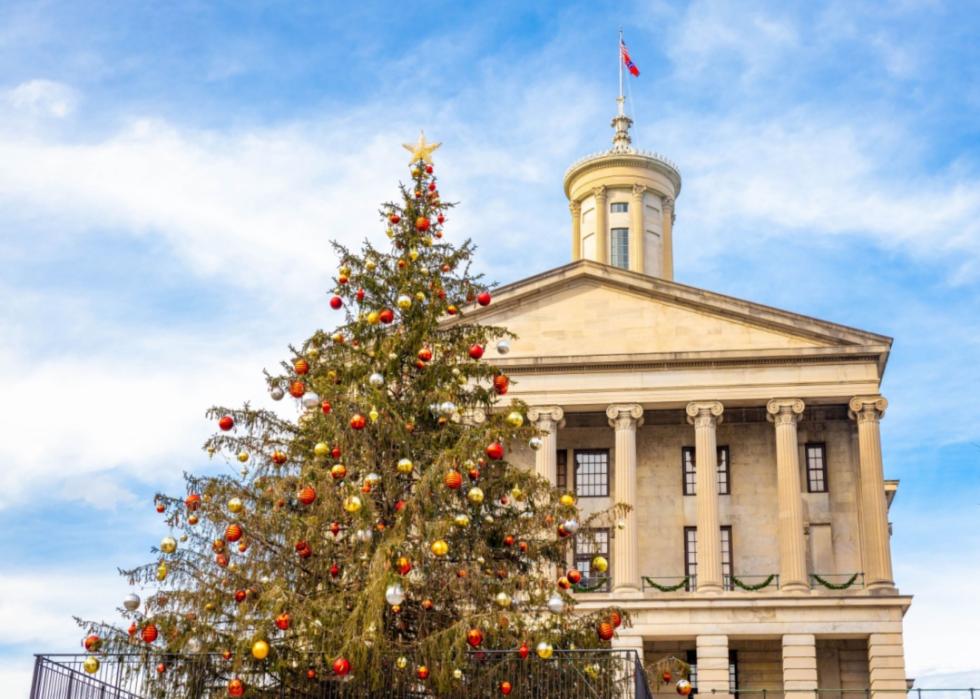
#30. Tennessee
– Total trees cut in 2022: 12,129
– Total farms: 214
– Total acres in production: 1,585
– Total sales: $578,000Tennessee's most common Christmas tree varieties are the eastern white pine, Fraser fir, Leyland cypress, Norway spruce, Scotch pine, and Arizona cypress. The Tennessee Christmas Tree Growers Association was founded in 1971 and helped the Tennessee Department of Agriculture Division of Forestry establish Christmas tree seed orchards.

#29. Idaho
– Total trees cut in 2022: 15,980
– Total farms: 101
– Total acres in production: 746
– Total sales: $673,000The Boise National Forest in Idaho sells as many as 5,000 permits yearly for Idahoans to chop their own Christmas tree, with approximately 1,000 of those permits going to people living in Idaho City. Some even suggest making a day out of the venture, with a bonfire and picnic packed with hot cocoa or s'mores.

#28. Oklahoma
– Total trees cut in 2022: 21,352
– Total farms: 64
– Total acres in production: 1,523
– Total sales: $915,000The Oklahoma Forestry Services urges residents to purchase fresh, Oklahoma-bred trees to support the state's agricultural industries and forge a connection with rural Oklahoma. Oklahoma's most commonly grown Christmas tree is the Virginia pine, which takes four to five years to grow into an average-sized Christmas tree.
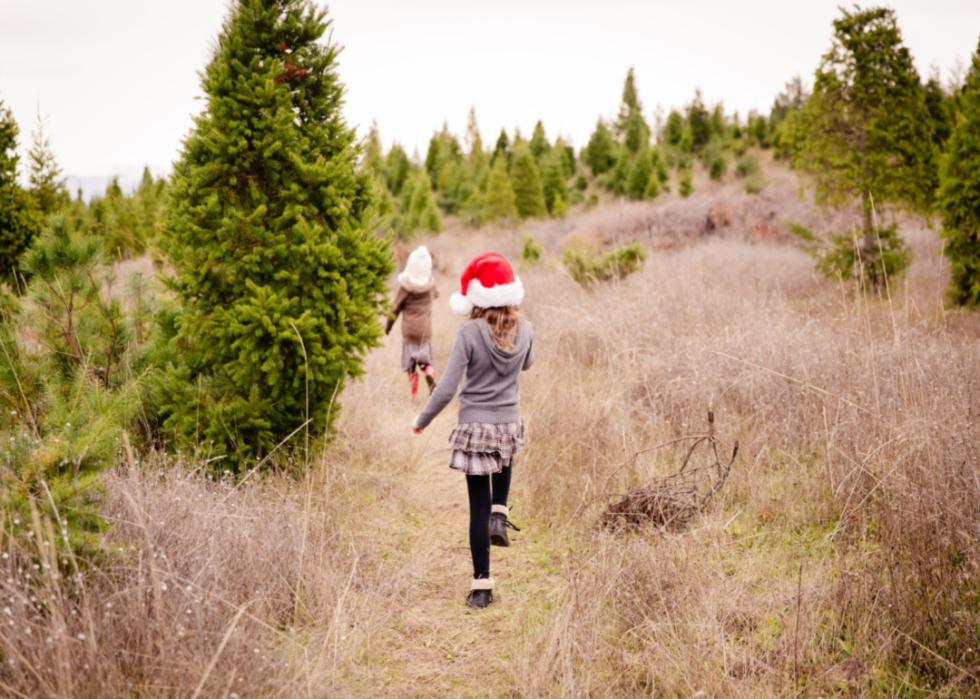
#27. Missouri
– Total trees cut in 2022: 21,461
– Total farms: 181
– Total acres in production: 1,944
– Total sales: $1.12 millionThe Missouri Department of Conservation suggests utilizing Christmas trees after the holiday season. From providing wildlife shelter to bonfire kindling, there are myriad ways to keep these living trees out of the waste stream and put them to good use.
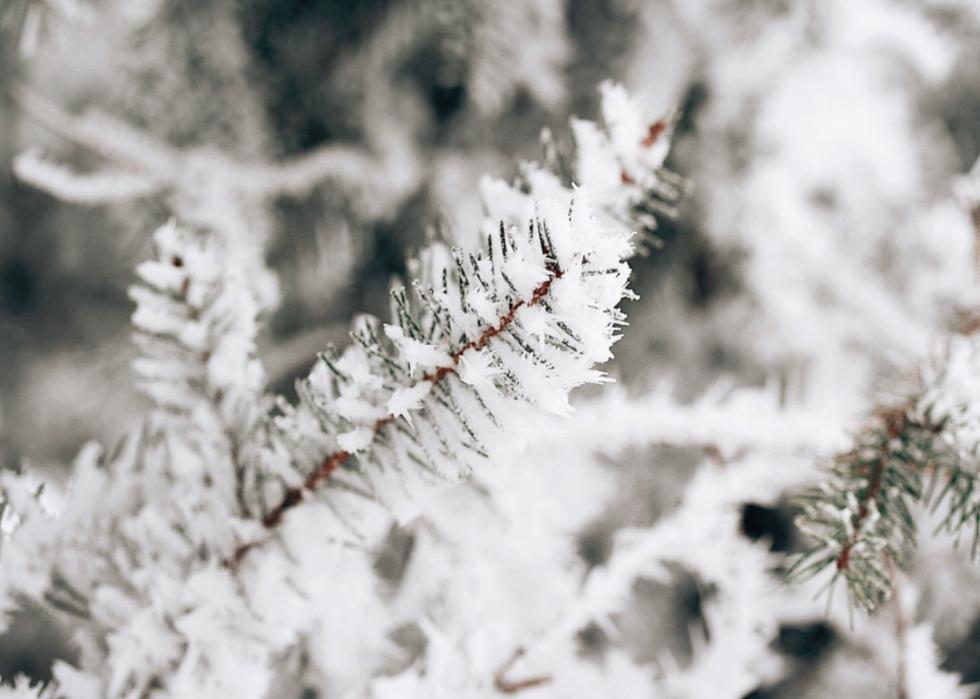
#26. Iowa
– Total trees cut in 2022: 21,826
– Total farms: 188
– Total acres in production: 1,526
– Total sales: $1.17 millionIowan families can visit one of nearly 200 choose-and-cut Christmas tree farms in Iowa to find the perfect centerpiece for their homes. The bestselling tree varieties in the state are the Scotch pine and the white pine.
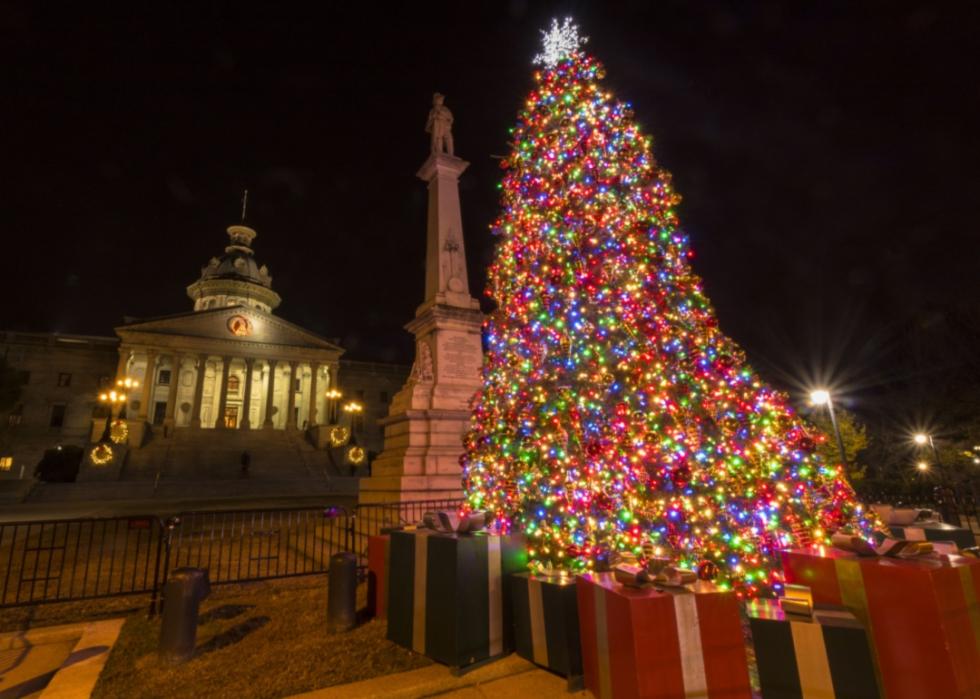
#25. South Carolina
– Total trees cut in 2022: 23,317
– Total farms: 152
– Total acres in production: 1,350
– Total sales: $1.15 millionPopular Christmas tree varieties in South Carolina include the Carolina sapphire, the blue ice, the Leyland and Murray cypress, the eastern red cedar, and the Deodar cedar. The South Carolina Christmas Tree Association also supports the Trees for Troops program, which provides Christmas trees to military personnel.
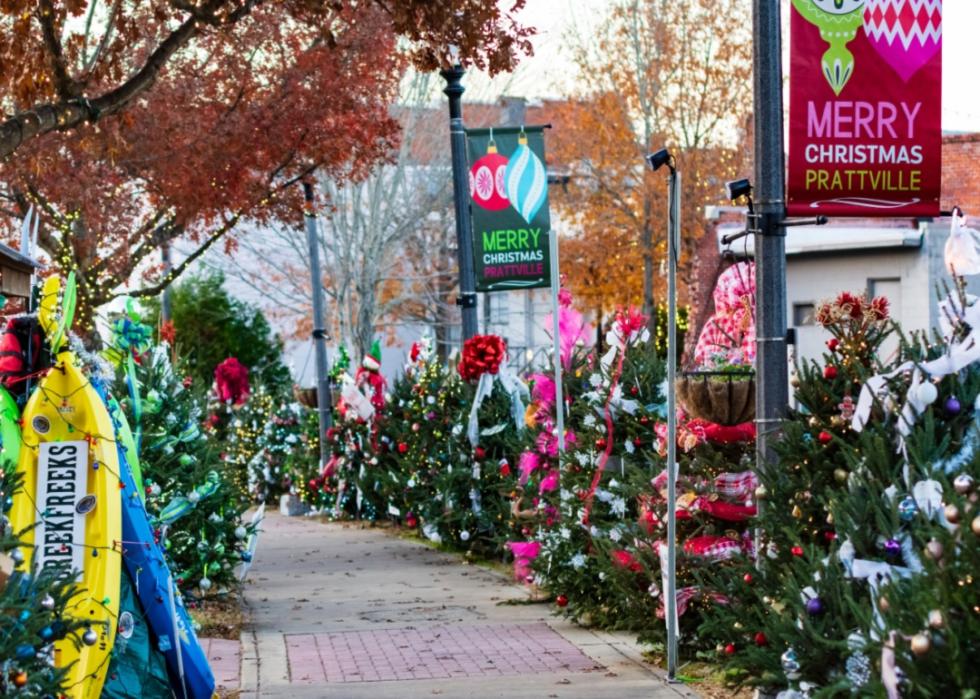
#24. Alabama
– Total trees cut in 2022: 24,586
– Total farms: 141
– Total acres in production: 999
– Total sales: $1.20 millionThe Leyland cypress is the most popular Christmas tree variety in Alabama, but it requires year-round work. Farmers must trim the trees two to three times yearly to maintain the classic cone shape associated with Christmas trees.
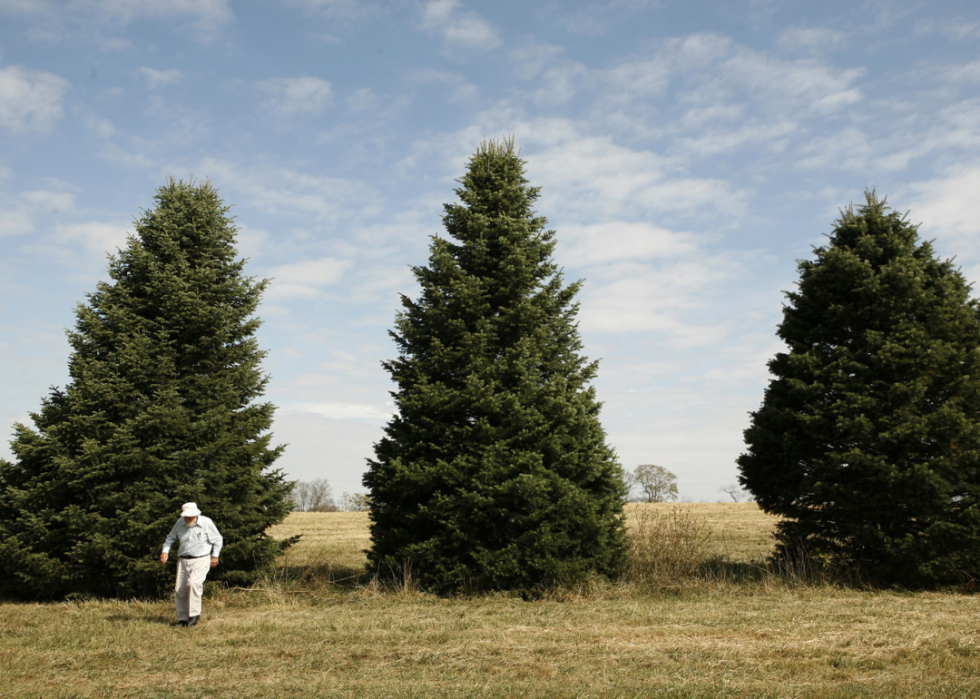
#23. West Virginia
– Total trees cut in 2022: 39,391
– Total farms: 252
– Total acres in production: 2,615
– Total sales: Not availableFor most of West Virginia's history, fresh Christmas trees came from Maine or Canada. Still, after World War II, Christmas tree farming moved south and became a profitable business in West Virginia. The most popular tree varieties are the Scotch pine and the white pine, but farmers also grow more expensive types, including Norway spruces, blue spruces, and Douglas firs.
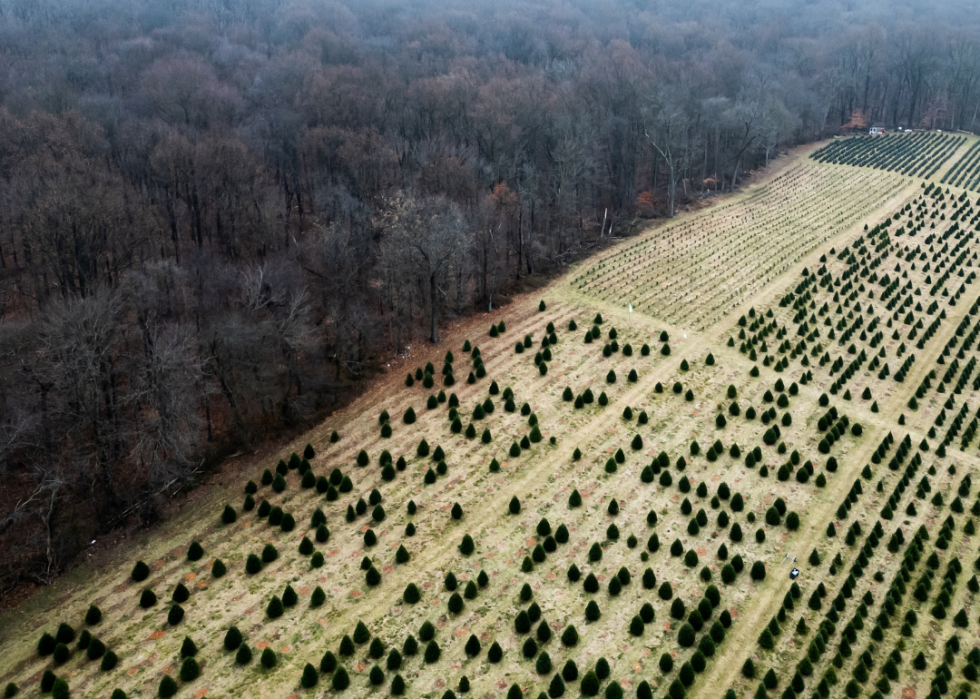
#22. Maryland
– Total trees cut in 2022: 40,697
– Total farms: 196
– Total acres in production: 1,889
– Total sales: $2.97 millionChristmas tree varieties grown and sold in Maryland include the Scotch pine, white pine, blue spruce, Douglas fir, Fraser fir, and Canaan fir. The Maryland Christmas Tree Association, with over 75 members, promotes the "real Christmas tree industry."
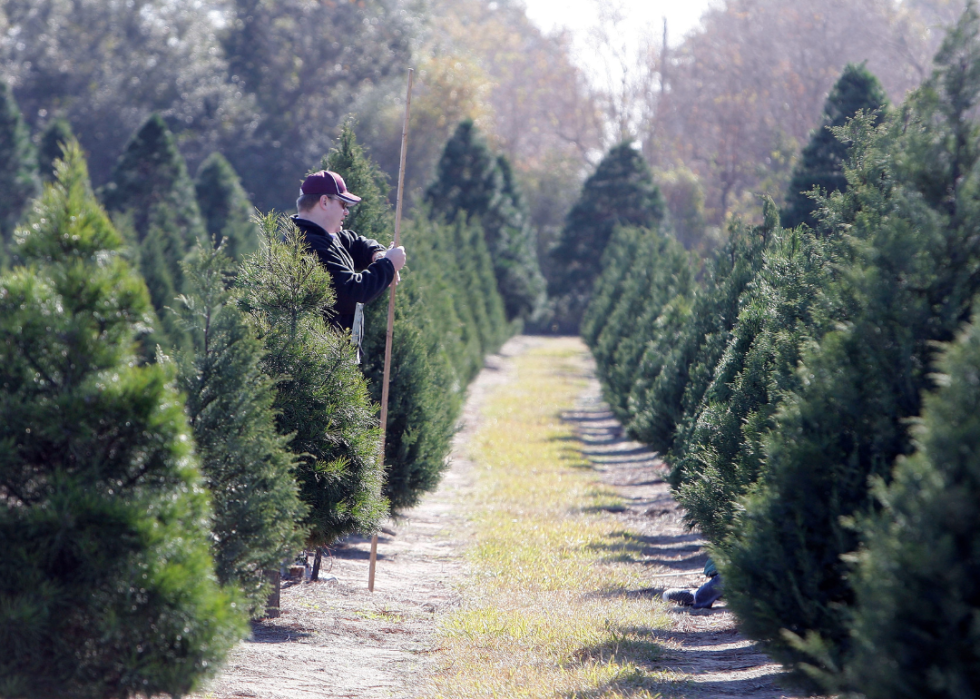
#21. Texas
– Total trees cut in 2022: 43,668
– Total farms: 220
– Total acres in production: 3,565
– Total sales: $1.57 millionSince Texas experiences hot and dry summers and has a limited soil variety, only a few types of Christmas trees thrive within the state. Texans can choose from a Virginia pine—the most common Christmas tree variety in the South—an Afghan pine, Leyland cypress, or Carolina sapphire.
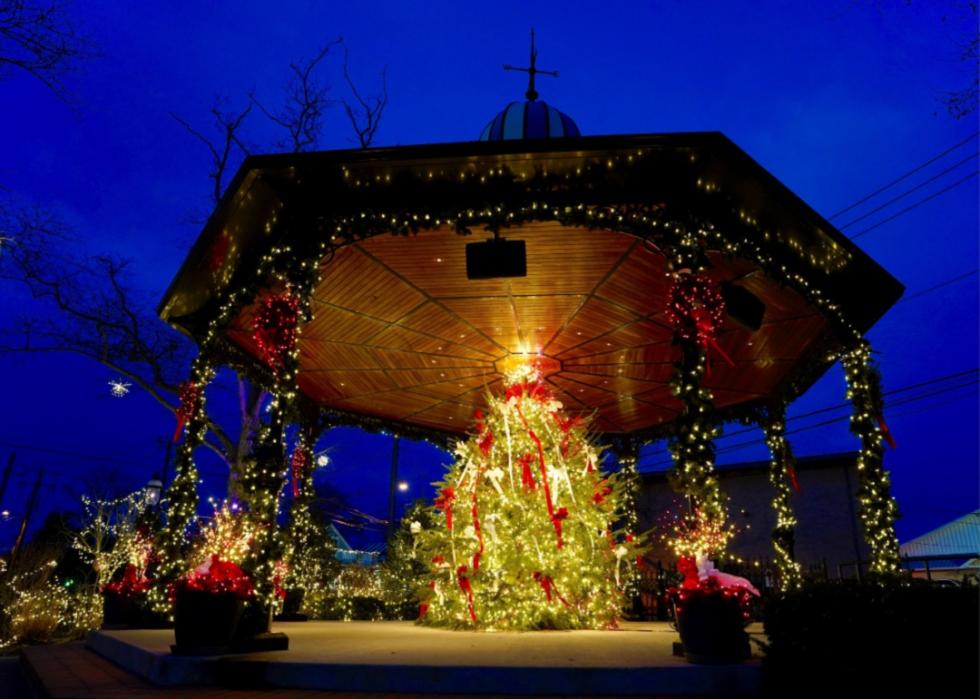
#20. New Jersey
– Total trees cut in 2022: 58,817
– Total farms: 883
– Total acres in production: 5,032
– Total sales: $3.32 millionReportedly, only one Christmas tree farmer in New Jersey plants trees from seeds. The rest are planted as seedlings, bare-root plants, or plugs because the trees don't reproduce until they reach maturity at around 20 years old. Popular varieties in New Jersey include the Scotch pine and Douglas fir, as well as balsam and concolor firs.
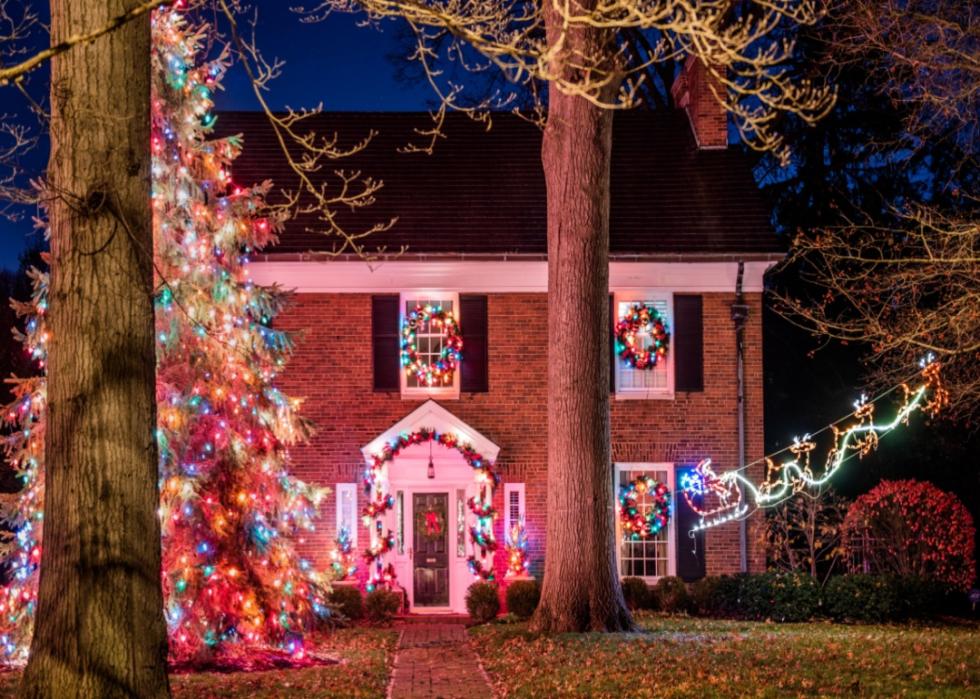
#19. Indiana
– Total trees cut in 2022: 60,841
– Total farms: 273
– Total acres in production: 3,135
– Total sales: $3.67 millionIndiana families can choose a Scotch pine, Douglas fir, white pine, Canaan fir, or Fraser fir as their Christmas tree. In addition to trees, many Indiana Christmas tree farms offer fresh wreaths, garlands, and tree accessories.
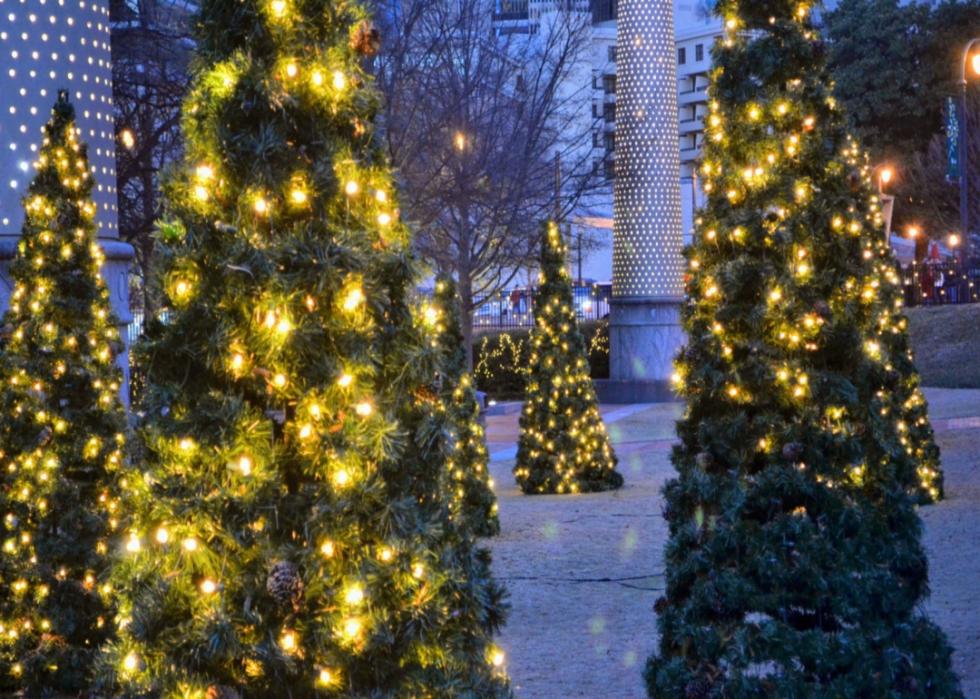
#18. Georgia
– Total trees cut in 2022: 63,915
– Total farms: 299
– Total acres in production: 2,199
– Total sales: $3.74 millionThough Fraser firs are some of the most popular Christmas trees in Georgia, most sold in Georgia come from North Carolina. The Peach State's hot summers and mild winters make growing Fraser firs challenging, and they can become infected with a root fungus. However, as of 2023, state researchers are working to develop a fungus-resistant tree better suited to Georgia's variable climate.
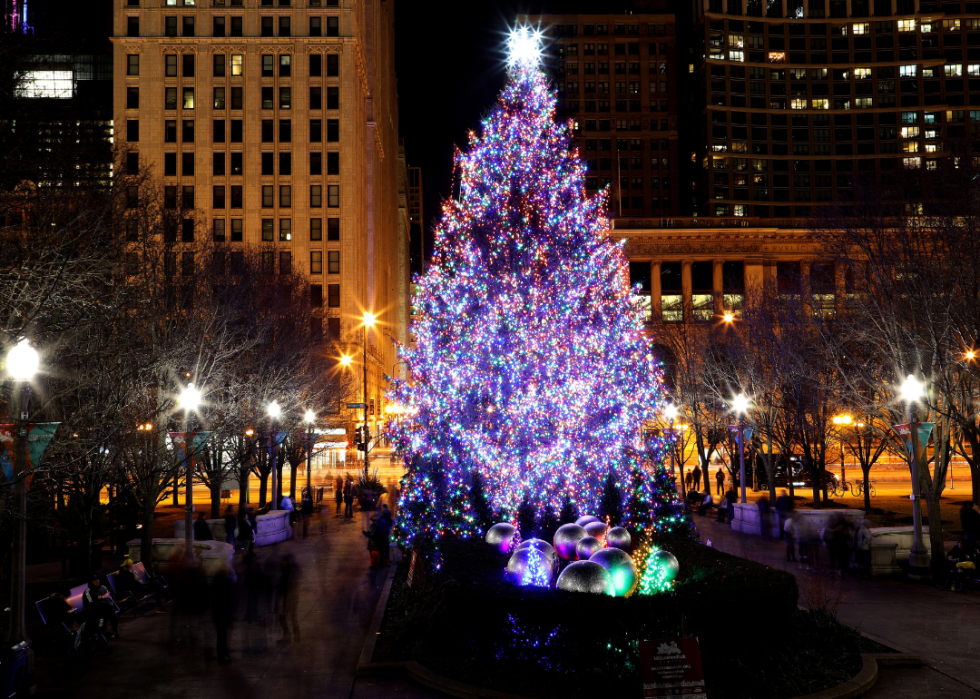
#17. Illinois
– Total trees cut in 2022: 68,681
– Total farms: 310
– Total acres in production: 4,129
– Total sales: Not availableIn 1913, the tradition of an official Chicago Christmas tree started when Mayor Carter H. Harrison lit the city's first tree in Grant Park. Although Illinois has an abundance of Christmas tree farms, the artificial Christmas tree was first manufactured in Chicago in 1958.
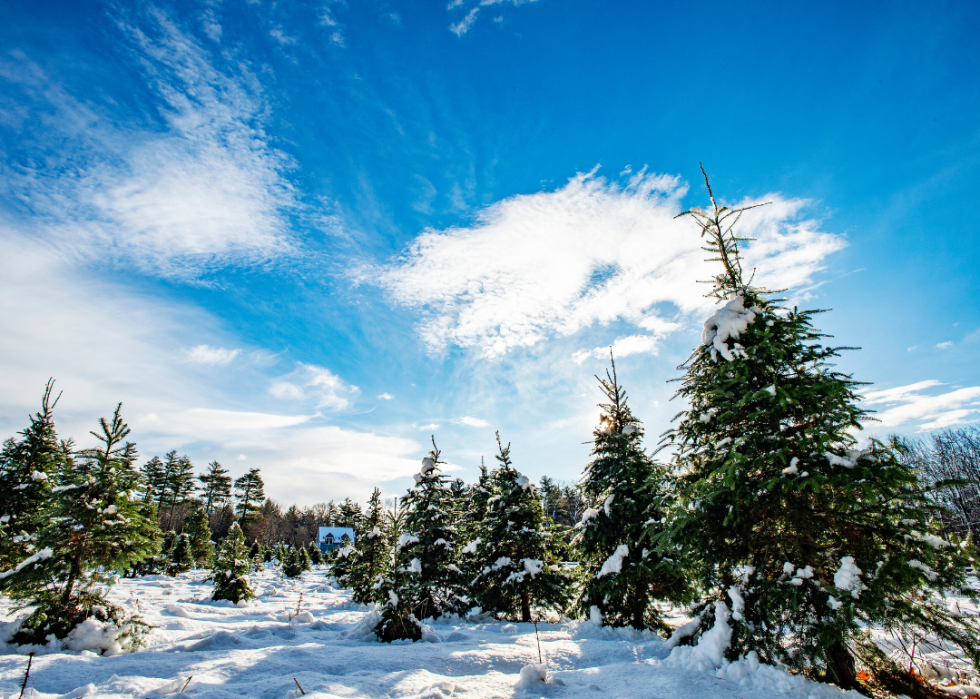
#16. Massachusetts
– Total trees cut in 2022: 78,630
– Total farms: 459
– Total acres in production: 2,952
– Total sales: $4.54 millionMassachusetts-bred Christmas trees include the balsam, concolor, Fraser, Douglas, and Noble fir, as well as the Scotch and white pine. The Massachusetts Department of Environmental Protection also recycles Christmas trees in more than 200 cities and towns after the holiday season.
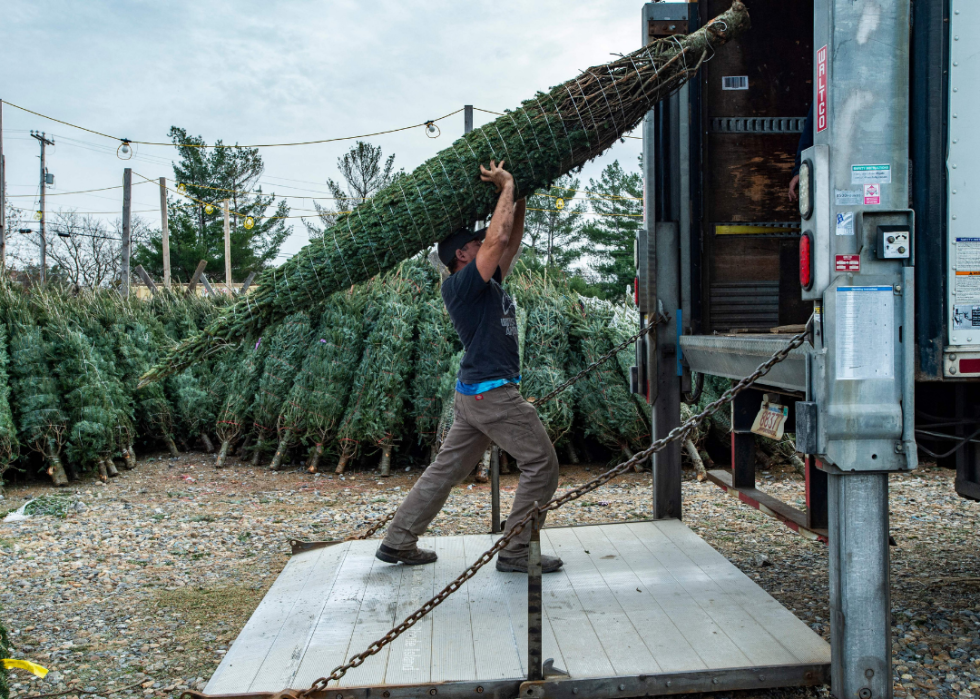
#15. New Hampshire
– Total trees cut in 2022: 79,323
– Total farms: 278
– Total acres in production: 3,425
– Total sales: $3.29 millionMost Christmas tree farms in New Hampshire are family owned and operated. Visitors can pick out and chop down their own tree at one of the state's many farms or choose from a precut tree.
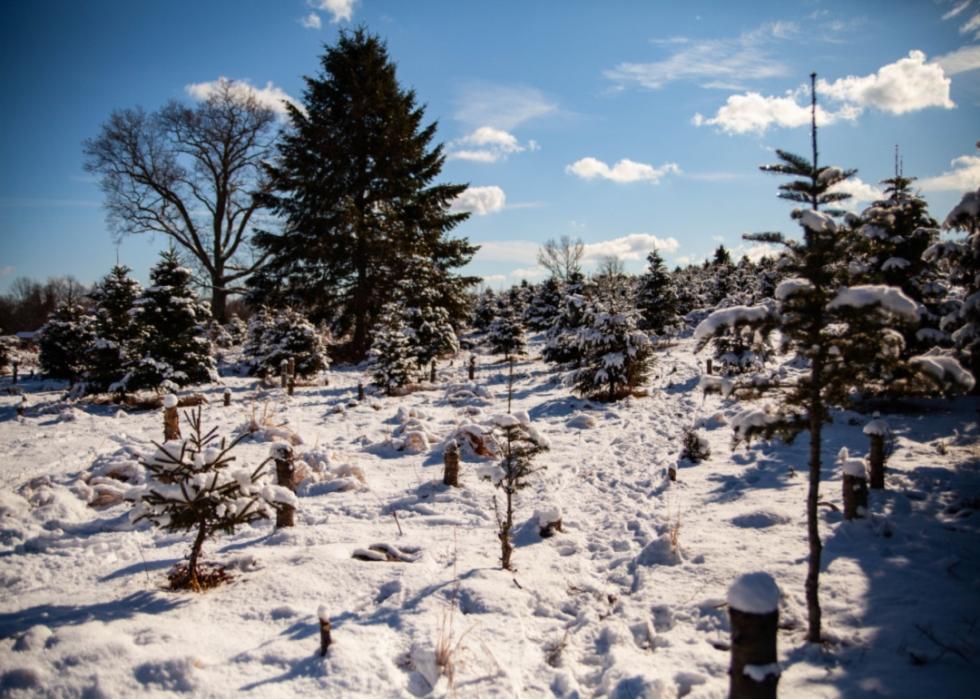
#14. Connecticut
– Total trees cut in 2022: 88,893
– Total farms: 547
– Total acres in production: 4,039
– Total sales: $5.02 millionConnecticut only grows one type of Christmas tree native to the state: the white pine. In all, however, at least a dozen varieties of conifers can be grown in Connecticut. The Scotch pine used to be produced in the state, but it became too vulnerable to insects and diseases.
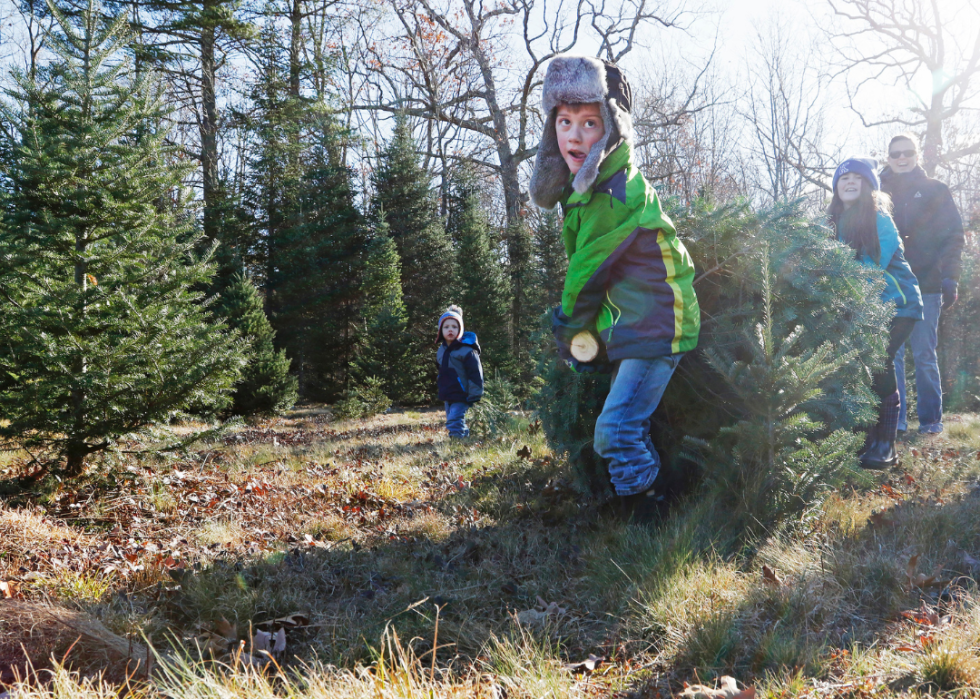
#13. Maine
– Total trees cut in 2022: 94,425
– Total farms: 370
– Total acres in production: 3,050
– Total sales: $3.44 millionMost Maine Christmas trees are Canadian hemlocks, concolor firs, Austrian pines, and blue or white spruces. The white spruce is the most commonly sold spruce in the area.
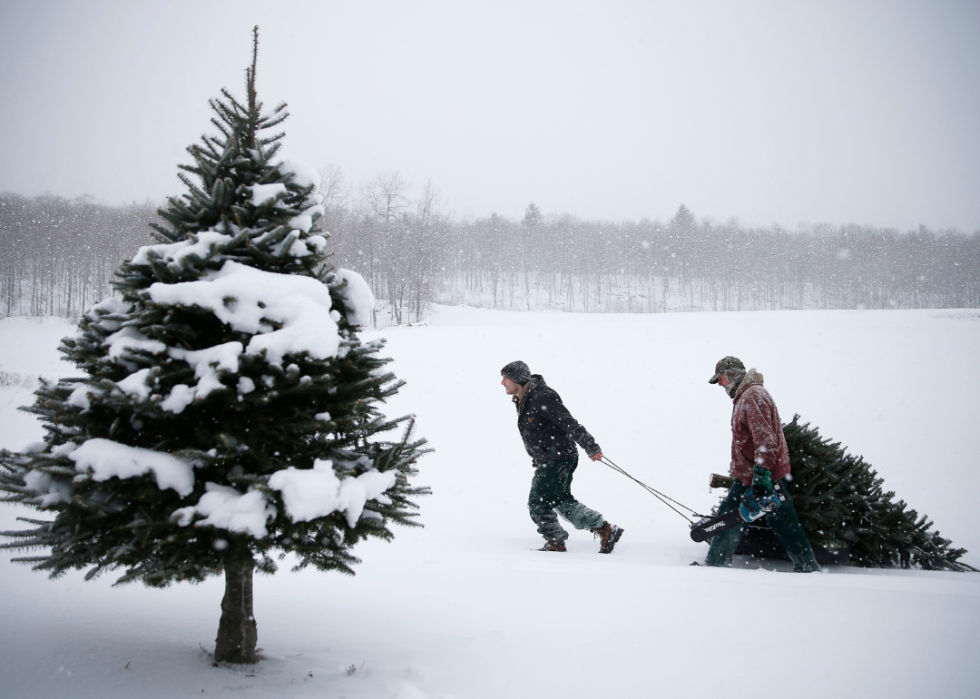
#12. Vermont
– Total trees cut in 2022: 127,121
– Total farms: 266
– Total acres in production: 3,495
– Total sales: $4.46 millionPopular Christmas tree varieties in New England include the Scotch pine, white pine, white spruce, blue spruce, balsam fir, and Douglas fir. These trees are conifers, meaning they produce cones with needles instead of leaves.

#11. California
– Total trees cut in 2022: 130,730
– Total farms: 334
– Total acres in production: 5,266
– Total sales: $8.33 millionThe climate in California isn't particularly hospitable to farming Christmas trees, so about 45% of Christmas trees harvested in the Pacific Northwest end up in California, according to the Pacific Northwest Christmas Tree Association. However, the silvertip tree grows in California and is sourced from the Sierra Nevada mountain range. Due to its sturdy shape, the silvertip is considered the perfect shape for a Christmas tree.

#10. Minnesota
– Total trees cut in 2022: 153,600
– Total farms: 378
– Total acres in production: 7,127
– Total sales: Not availableMinnesota Christmas tree farmers sell about 150,000 Christmas trees each year. The most popular tree varieties in the state are the balsam fir, Fraser fir, and Scotch pine. However, the Norway pine, white pine, and Colorado spruce are also common.
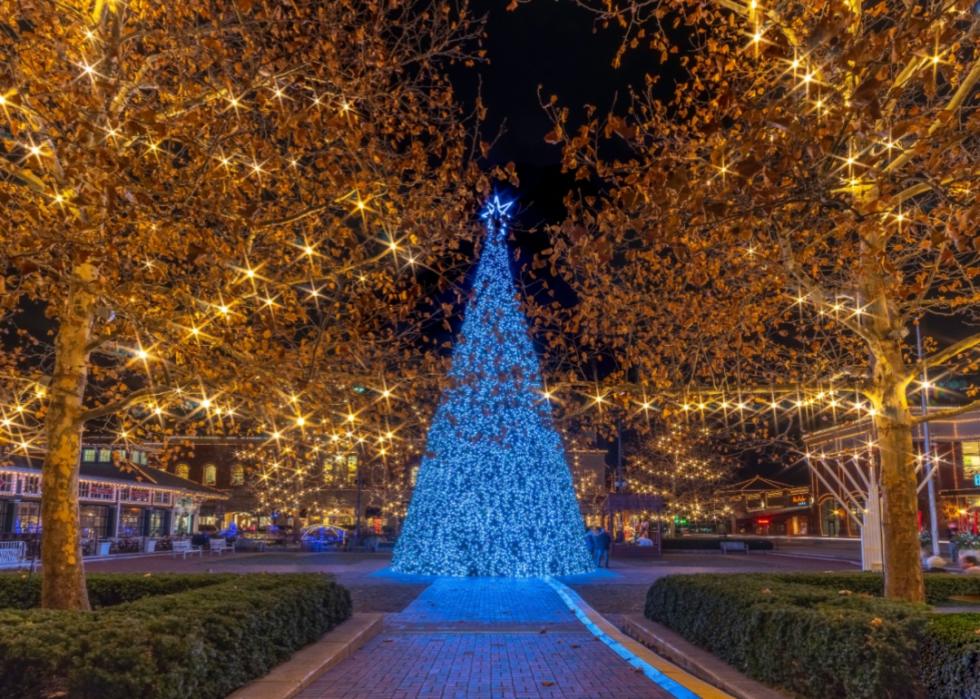
#9. Ohio
– Total trees cut in 2022: 189,240
– Total farms: 777
– Total acres in production: 8,946
– Total sales: $11.24 millionOhio families can choose between several species for their Christmas tree: the Austrian pine, Scotch pine, eastern white pine, red pine, southwestern white pine, Norway spruce, or Serbian spruce. However, the Scotch pine is the most popular in Ohio, thanks to its strong needle retention and firm branches.
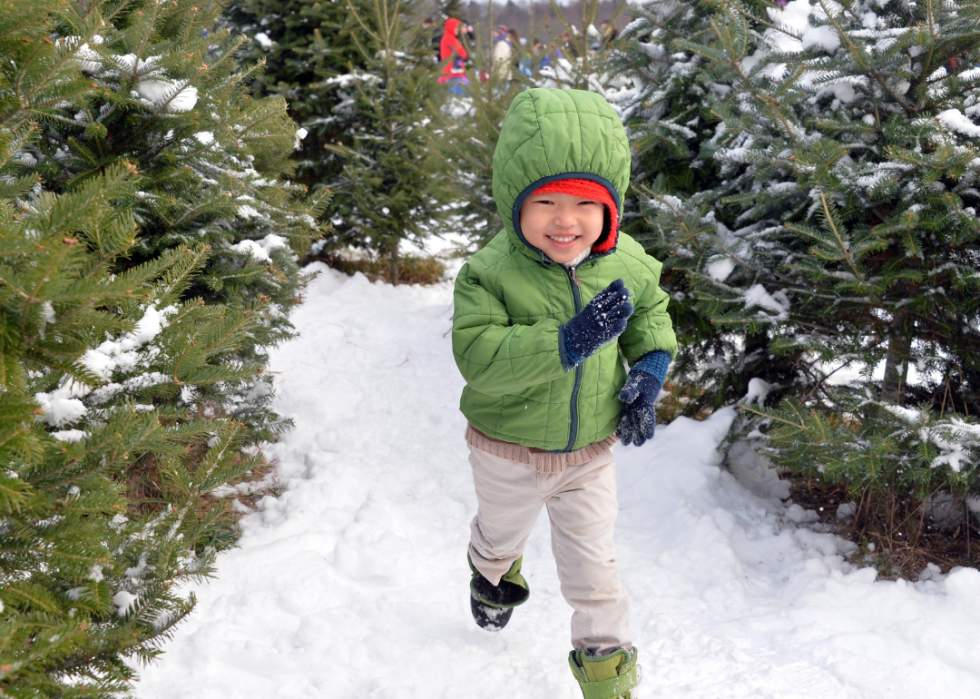
#8. New York
– Total trees cut in 2022: 318,745
– Total farms: 1,226
– Total acres in production: 22,583
– Total sales: Not availableIt takes seven to 12 years to grow a healthy, 7-foot Christmas tree in New York. The most common long-needled tree in the state is the Scots pine; the state's most common short-needled tree is the Douglas fir.

#7. Virginia
– Total trees cut in 2022: 578,777
– Total farms: 480
– Total acres in production: 9,805
– Total sales: $25.58 millionThe Eastern white pine is the most widely planted Christmas tree variety in Virginia due to its adaptability and excellent needle retention. Despite its name, the Virginia pine is a relatively new species to the state and performs better in the Deep South.
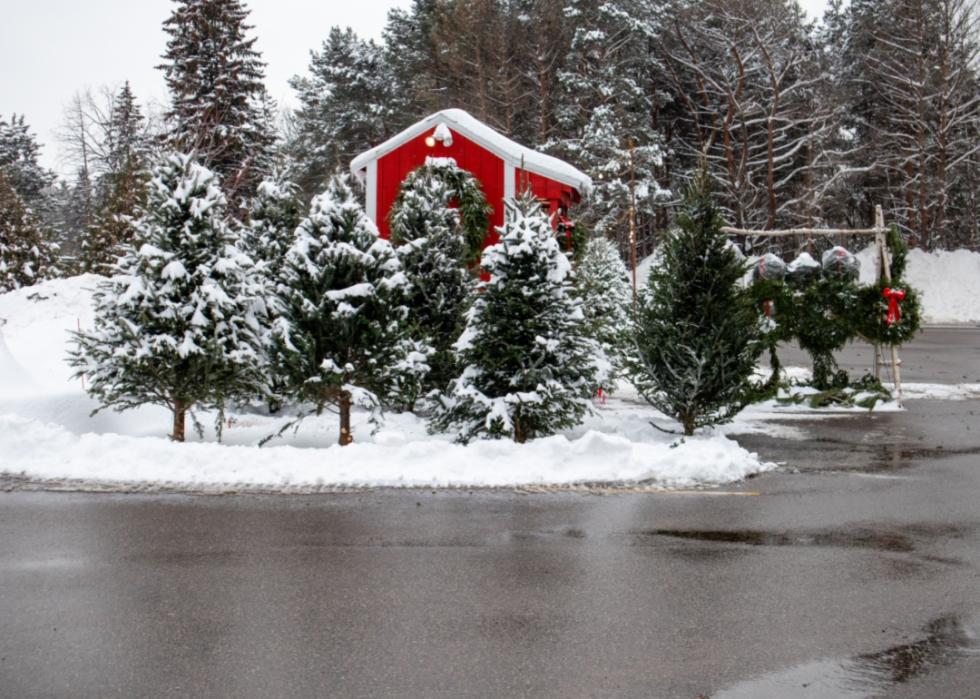
#6. Wisconsin
– Total trees cut in 2022: 601,199
– Total farms: 941
– Total acres in production: 25,975
– Total sales: $21.70 millionThe 2017 White House Christmas tree came from Wisconsin. It was grown by the owners of Silent Night Evergreens in Endeavor, Wisconsin, who won the 2017 National Christmas Tree Contest. In 2016, the winning Christmas tree also came from Wisconsin.
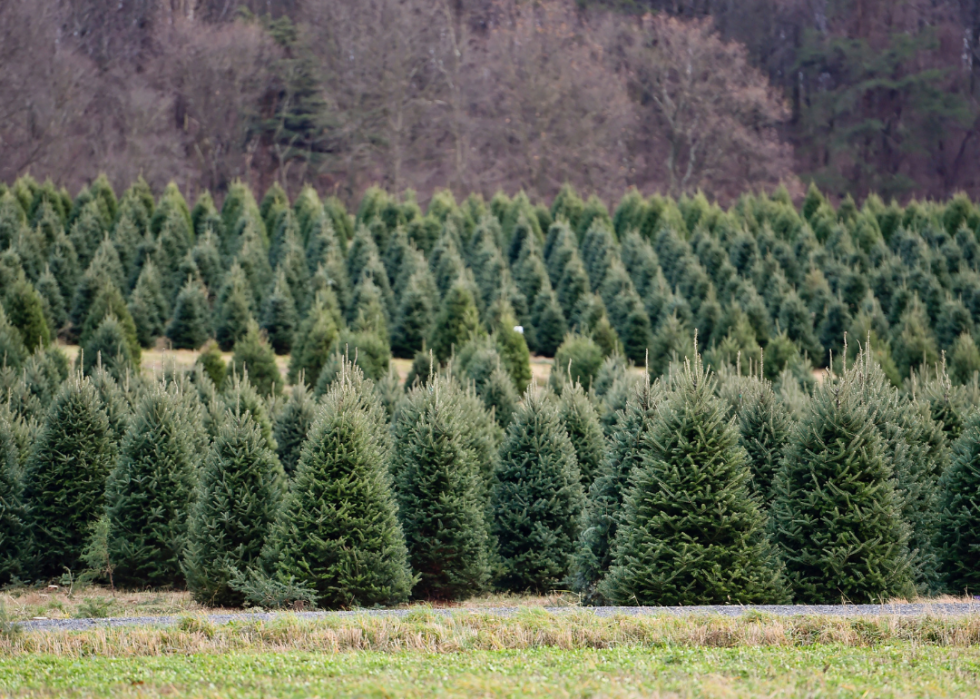
#5. Pennsylvania
– Total trees cut in 2022: 721,480
– Total farms: 1,301
– Total acres in production: 24,697
– Total sales: $31.41 millionPennsylvania harvests more than half a million Christmas trees each holiday season. If you combine all the acres the state devotes to growing Christmas trees, it would cover more than 49 square miles.
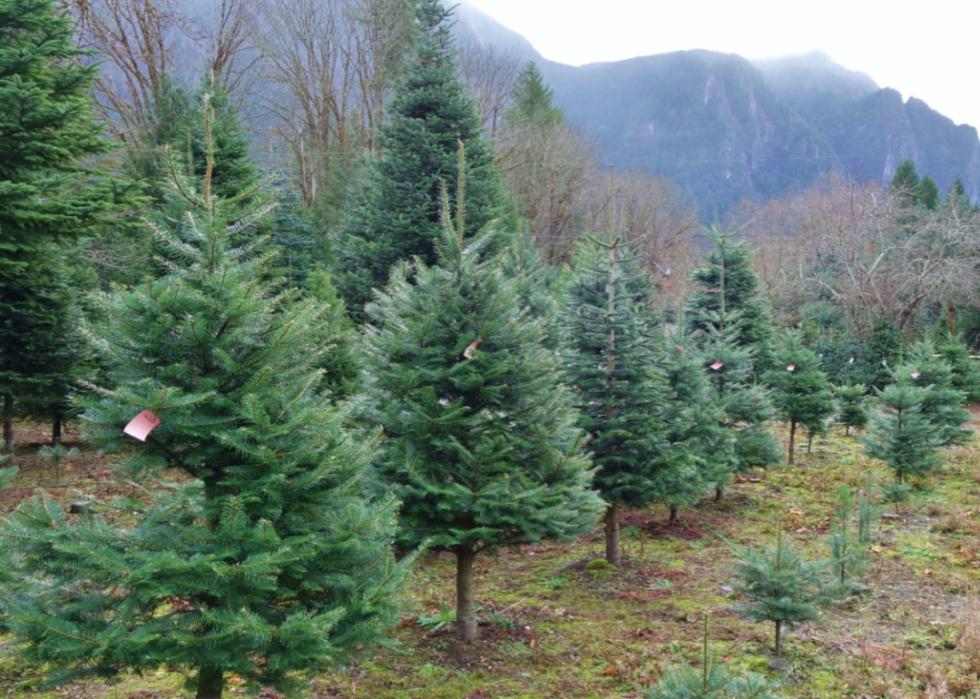
#4. Washington
– Total trees cut in 2022: 936,904
– Total farms: 756
– Total acres in production: 13,245
– Total sales: Not availableMany rural landowners in southwest Washington benefit from farming Christmas trees, thanks to the long growing season and mild winters that contribute to the fir trees' production. Furthermore, Washington state's cool fall harvesting season and high humidity ensure the longevity of Christmas trees after they are cut.
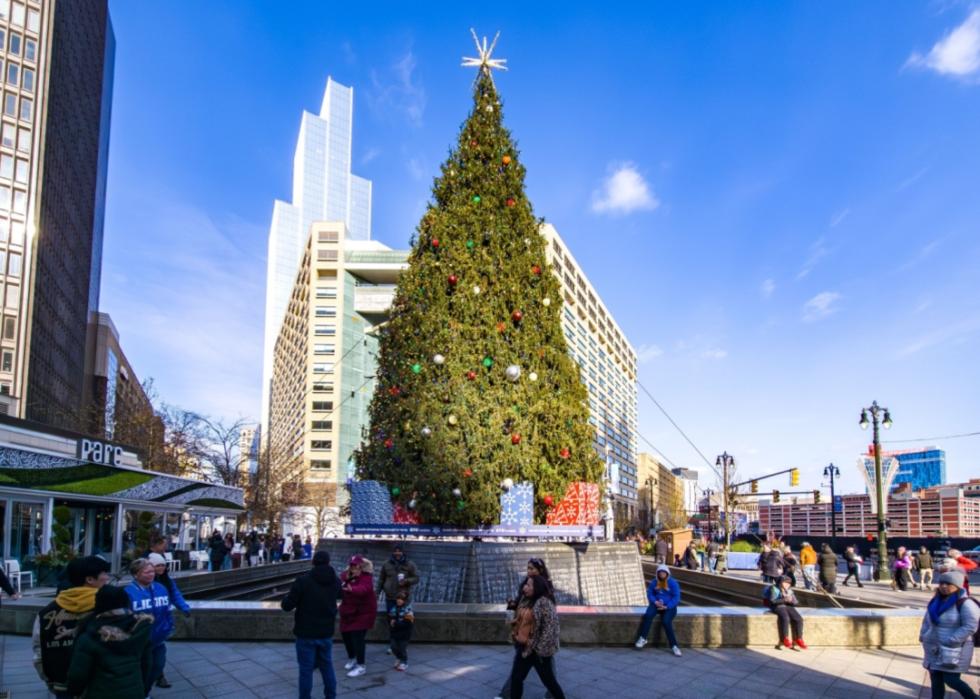
#3. Michigan
– Total trees cut in 2022: 1,799,391
– Total farms: 1,236
– Total acres in production: 33,135
– Total sales: $48.91 millionThe most popular Christmas trees in Michigan are the Scotch pine, white pine, blue spruce, black hills spruce, balsam fir, concolor fir, Douglas fir, and Fraser fir. In 2017, Amazon began selling and delivering Michigan Christmas trees to families across the country.
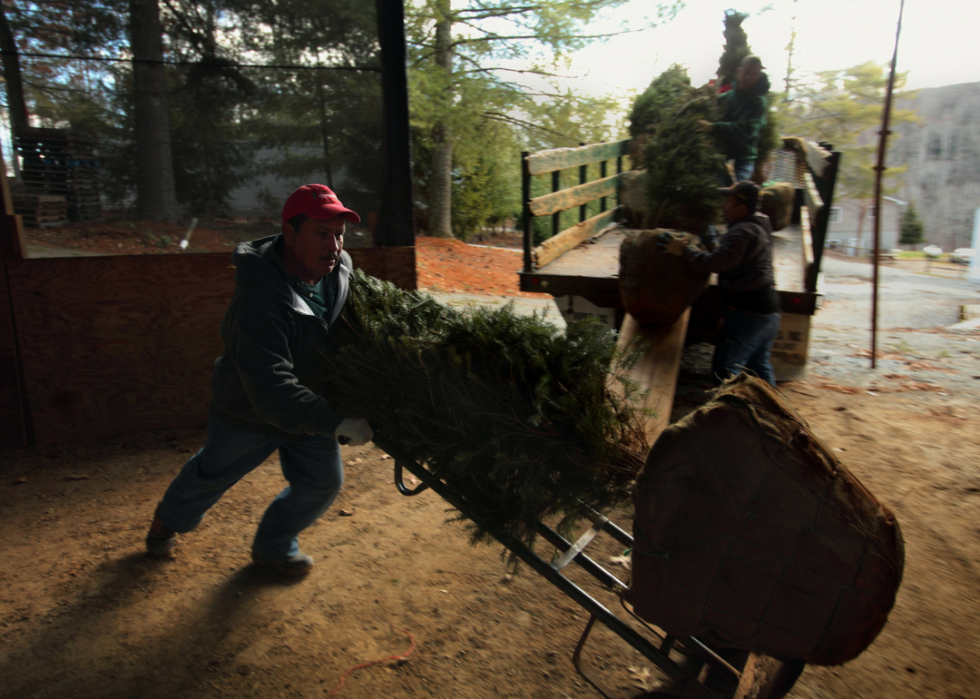
#2. North Carolina
– Total trees cut in 2022: 3,208,419
– Total farms: 940
– Total acres in production: 33,126
– Total sales: $123.66 millionThe Fraser fir comprises all Christmas tree varieties grown in North Carolina. The North Carolina Fraser fir is shipped annually to every state in the United States and the Caribbean Islands, Mexico, Canada, Bermuda, and Japan. North Carolina is a Christmas tree-producing giant, growing more than 1 in 5 Christmas trees in the country.
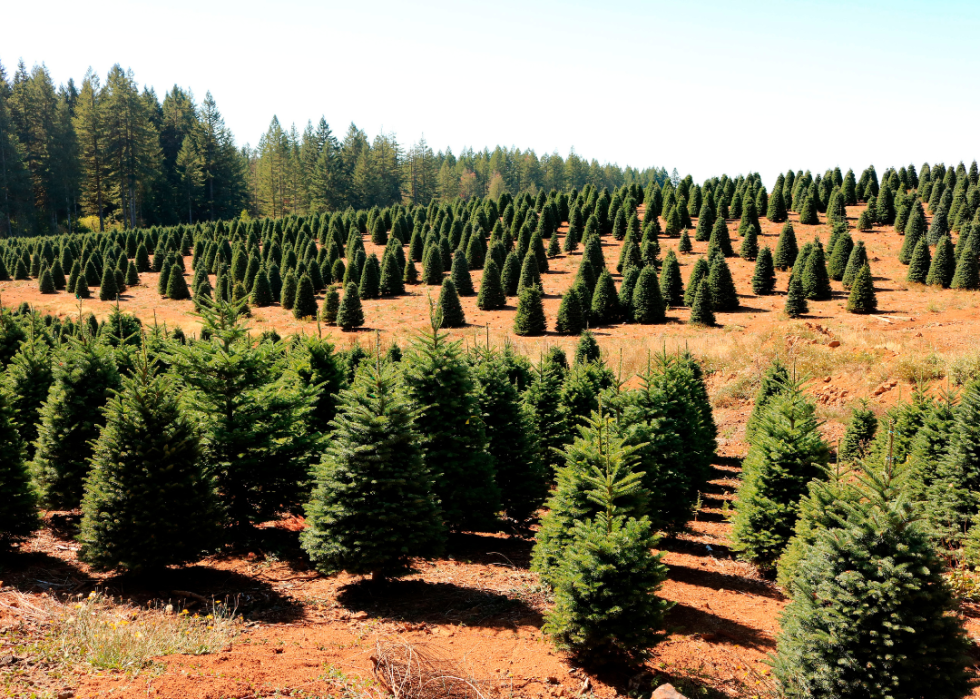
#1. Oregon
– Total trees cut in 2022: 4,823,877
– Total farms: 1,695
– Total acres in production: 48,433
– Total sales: $167.34 millionOregon's title as the state that produces the most Christmas trees isn't even a close race—it outpaces North Carolina (the #2 state) by more than 1 million trees. Ninety-two percent of Oregonian Christmas trees are shipped outside the state, and in 2023, estimated Christmas tree sales totaled more than $117 million.
Story editing by Cu Fleshman. Copy editing by Kristen Wegrzyn and Paris Close. Photo selection by Lacy Kerrick.



